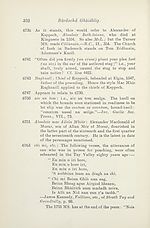Download files
Complete book:
Individual page:
Thumbnail gallery: Grid view | List view

Notes.
331
keeps milk to the dappled spotted fawns; Duncan
Macintyre Moladh Beinn Dobhrain. The “foster
mother” here is the rich grass of the forest.
6684 The rhyme rdnan: Meuran is notable; it would be a
good rhyme in Lochaber Gaelic at the present day,
where, e.g., ban (pronounced bean) rhymes with
dean; cf. 3213 n.
6687 b’annsa leam, etc.; compare Buile Suibhne (The Frenzy
of Suibhne) (Irish Text Soc. XII., p. 78)—
Nf charaim an chornairecht
atcluinnim go tenn;
binne lium an damhghairecht
damh da fhiched beann.
“I love not the horn-blowing so boldly I hear;
sweeter to me the belling of stags of twice twenty
peaks.”
6689 am bi gne dhuinnid: “in whom is the nature of
dunness;” whose natural hue is dun.
6690 ri sin: facing storm; dative of sian, fern., gen. sine.
The sentiment of these quatrains is similar to that
in Buile Suibne (Ir. Texts Soc., Vol. XII.), pp.
58, 78.
6707 Other versions have i for mi here, and in 1. 6708—with
reference to creag.
The oldest copy (1755) reads—
cha rabh u riamh ag eisteacht
re sheitrich no muic mara
ach s, minic chuall u moran
de chronanich n, daimh allid.
(In this MS. the apostrophe is always placed as a
comma after the word whose initial letter is
omitted.)
6715 The old style of hunting is described in The Celtic
Review, IX., 156, and in The Book of the Bed
Deer (1925).
6728 ced; see note on line 777—ni fhuil acht ce6, etc.
6731 Alasdair nan Gleann: a Chief of Keppoch who
flourished in the latter part of the fifteenth
century. He fought at Blar na Pairce, the Battle
of Park, c. 1491.
331
keeps milk to the dappled spotted fawns; Duncan
Macintyre Moladh Beinn Dobhrain. The “foster
mother” here is the rich grass of the forest.
6684 The rhyme rdnan: Meuran is notable; it would be a
good rhyme in Lochaber Gaelic at the present day,
where, e.g., ban (pronounced bean) rhymes with
dean; cf. 3213 n.
6687 b’annsa leam, etc.; compare Buile Suibhne (The Frenzy
of Suibhne) (Irish Text Soc. XII., p. 78)—
Nf charaim an chornairecht
atcluinnim go tenn;
binne lium an damhghairecht
damh da fhiched beann.
“I love not the horn-blowing so boldly I hear;
sweeter to me the belling of stags of twice twenty
peaks.”
6689 am bi gne dhuinnid: “in whom is the nature of
dunness;” whose natural hue is dun.
6690 ri sin: facing storm; dative of sian, fern., gen. sine.
The sentiment of these quatrains is similar to that
in Buile Suibne (Ir. Texts Soc., Vol. XII.), pp.
58, 78.
6707 Other versions have i for mi here, and in 1. 6708—with
reference to creag.
The oldest copy (1755) reads—
cha rabh u riamh ag eisteacht
re sheitrich no muic mara
ach s, minic chuall u moran
de chronanich n, daimh allid.
(In this MS. the apostrophe is always placed as a
comma after the word whose initial letter is
omitted.)
6715 The old style of hunting is described in The Celtic
Review, IX., 156, and in The Book of the Bed
Deer (1925).
6728 ced; see note on line 777—ni fhuil acht ce6, etc.
6731 Alasdair nan Gleann: a Chief of Keppoch who
flourished in the latter part of the fifteenth
century. He fought at Blar na Pairce, the Battle
of Park, c. 1491.
Set display mode to:
![]() Universal Viewer |
Universal Viewer | ![]() Mirador |
Large image | Transcription
Mirador |
Large image | Transcription
| An Comunn Gàidhealach > An Comunn Gàidhealach Publications > Bardachd Ghaidhlig > (399) |
|---|
| Permanent URL | https://digital.nls.uk/126285920 |
|---|
| Description | This contains items published by An Comunn, which are not specifically Mòd-related. It includes journals, annual reports and corporate documents, policy statements, educational resources and published plays and literature. It is arranged alphabetically by title. |
|---|
| Description | A collection of over 400 items published by An Comunn Gàidhealach, the organisation which promotes Gaelic language and culture and organises the Royal National Mòd. Dating from 1891 up to the present day, the collection includes journals and newspapers, annual reports, educational materials, national Mòd programmes, published Mòd literature and music. |
|---|---|
| Additional NLS resources: |
|

